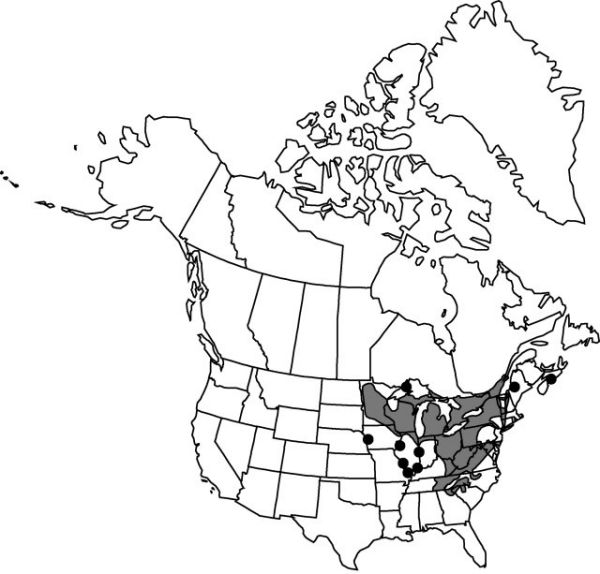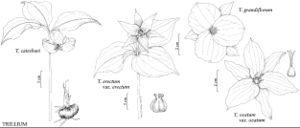Difference between revisions of "Trillium grandiflorum"
Parad. Lond. 1: plate 1. 1805.
FNA>Volume Importer |
imported>Volume Importer |
||
| Line 8: | Line 8: | ||
}} | }} | ||
|common_names=White trillium;great white trillium;white wake-robin;trille grandiflore | |common_names=White trillium;great white trillium;white wake-robin;trille grandiflore | ||
| + | |special_status={{Treatment/ID/Special_status | ||
| + | |code=F | ||
| + | |label=Illustrated | ||
| + | }}{{Treatment/ID/Special_status | ||
| + | |code=E | ||
| + | |label=Endemic | ||
| + | }} | ||
|basionyms={{Treatment/ID/Basionym | |basionyms={{Treatment/ID/Basionym | ||
|name=Trillium rhomboideum var. grandiflorum | |name=Trillium rhomboideum var. grandiflorum | ||
| Line 61: | Line 68: | ||
|publication title=Parad. Lond. | |publication title=Parad. Lond. | ||
|publication year=1805 | |publication year=1805 | ||
| − | |special status= | + | |special status=Illustrated;Endemic |
| − | |source xml=https:// | + | |source xml=https://bibilujan@bitbucket.org/aafc-mbb/fna-data-curation.git/src/bb6b7e3a7de7d3b7888a1ad48c7fd8f5c722d8d6/coarse_grained_fna_xml/V26/V26_103.xml |
|genus=Trillium | |genus=Trillium | ||
|subgenus=Trillium subg. Trillium | |subgenus=Trillium subg. Trillium | ||
Revision as of 22:12, 27 May 2020
Rhizomes short, thick, praemorse. Scapes (1–)2–3(–many), round in cross section, 1.5–3+ dm, thick, glabrous. Bracts sessile or subsessile (occasionally weakly cuneate basally); blade dark green with maroon overtones early, ovate-rhombic, 12–20 × 8–15 cm, apex acuminate. Flower outfacing, erect, odorless; sepals spreading, flat, green, very rarely streaked with maroon-purple, lanceolate, 20–55 × 12–23 mm, margins entire, apex acuminate or acute; petals erect basally, recurving somewhat above middle to produce strongly funnelform corolla, obscuring ovary and base of style, white or rarely pink, without V-shaped or other markings, fading to dull pinkish purple, veins of adaxial surface conspicuous but not appearing engraved, shape variable, lanceolate to oblong, obovate, or, rarely, suborbicular, sides often parallel, 4–7.5 × 2–4 cm, thin-textured, base abruptly attenuate, margins overlapping basally, rolled, undulate-wavy in distal 1/2, apex ± acuminate; stamens straight or barely recurved, 9–27 mm; filaments white, much shorter than anthers, relatively thin; anthers recurving slightly, pale yellow, strongly yellow when pollen exposed, long, 5–16 mm, slender, dehiscence introrse; ovary inconspicuous, pale green or white, ovoid, 6-angled, 8–18 mm, basal attachment narrower than ovary width; style barely united for 0.5–2 mm or merely closely grouped and separate; stigmas erect, becoming spreading, weakly connate basally, pale green-white, uniformly linear, 3–18 mm, equaling or exceeding ovary, slender; pedicel erect-ascending to strongly erect, 2–8+ cm. Fruits pale green, odorless, ± globose, obscurely 6-angled, 1.2–1.6 × 0.8–1.4 cm, mealy, moist (not juicy). 2n = 10.
Phenology: Late spring–early summer (Apr–Jun).
Habitat: Rich deciduous or mixed coniferous-deciduous upland woods, floodplains, roadsides
Elevation: 20–700 m
Distribution

N.S., Ont., Que., Conn., Del., Ga., Ill., Ind., Iowa, Ky., Maine, Md., Mass., Mich., Minn., N.H., N.J., N.Y., N.C., Ohio, Pa., S.C., Tenn., Vt., Va., W.Va., Wis.
Discussion
Most variants of Trillium grandiflorum have green stripes or markings on the petals, many with numerous (4–30+) extra petals and/or bracts, and, often, much-deformed, monstrous characteristics. G. R. Hooper et al. (1971) showed that mycoplasmic organisms were present in all such forms examined, and were absent from normal plants. Most such forms should not be named taxonomically but, unfortunately, many have been. Nearly all of those that I examined represented stages in the development of the mycoplasma infection. Trillium grandiflorum, unlike most trilliums, produces many-petaled “double” forms. Forma roseum Farwell, opening a striking clear salmon-pink, occurs very rarely throughout the range, but is frequent in mixed or pure colonies along the Blue Ridge Mountains of Virginia.
